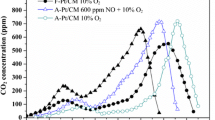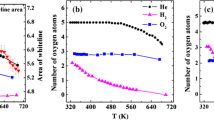Abstract
The deactivation of noble metal catalysts by SO2 and H2O is a common issue in the post combustion treatment of flue gases from sintering processes in the steel industry. In an effort to develop SO2-tolerant CO-oxidation catalysts, herein, we investigated the effect of SO2 and H2O on the catalytic activity of Pt/TiO2(P-25) catalysts for CO oxidation using X-ray photoelectron spectroscopy (XPS), transmission electron microscopy (TEM), and diffuse-reflectance infrared Fourier-transform (DRIFT) spectroscopy. Pt/TiO2(P-25) catalysts, in the absence of SO2 and presence of H2O, enhanced the activity and stability of CO oxidation, while being largely suppressed and irreversibly deactivated in the presences of SO2. The XPS and TEM results suggested that variations in the Pt particle size and oxidation state were not major causes of the deactivation. Instead, according to DRIFT spectra, the interaction between CO and H2O at the metal-support interface was weakened after the formation of TiOSO4 on the TiO2 surface in the presence of SO2. This resulted in a loss of the previously observed enhancement of CO oxidation under humid conditions. These results indicate that in the presence of SO2, the formation of TiOSO4 is the major cause of irreversible deactivation. Therefore, removal of the TiOSO4 layer from the TiO2 surface is a crucial step for catalyst regeneration.
Graphical Abstract









Similar content being viewed by others
References
Bagheri S, Muhd Julkapli N, Bee Abd Hamid S (2014) Titanium dioxide as a catalyst support in heterogeneous catalysis. Sci World J. https://doi.org/10.1155/2014/727496
Kimura K, Einaga H, Teraoka Y (2011) Preparation of highly dispersed platinum catalysts on various oxides by using polymer-protected nanoparticles. Catal Today 164:88–91. https://doi.org/10.1016/j.cattod.2010.10.006
Matsumoto S, Ikeda Y, Suzuki H et al (2000) NOx storage-reduction catalyst for automotive exhaust with improved tolerance against sulfur poisoning. Appl Catal B Environ 25:115–124. https://doi.org/10.1016/S0926-3373(99)00124-1
Irfan MF, Goo JH, Kim SD, Hong SC (2007) Effect of CO on NO oxidation over platinum based catalysts for hybrid fast SCR process. Chemosphere 66:54–59. https://doi.org/10.1016/j.chemosphere.2006.05.044
Hirata H, Hachisuka I, Ikeda Y et al (2001) NOx storage-reduction three-way catalyst with improved sulfur tolerance. Top Catal 16:145–149. https://doi.org/10.1023/A:1016603502952
Xue E, Seshan K, Ross JRH (1996) Roles of supports, Pt loading and Pt dispersion in the oxidation of NO to NO2 and of SO2 to SO3. Appl Catal B Environ 11:65–79. https://doi.org/10.1016/S0926-3373(96)00034-3
Taira K, Nakao K, Suzuki K, Einaga H (2016) SOx tolerant Pt/TiO2 catalysts for CO oxidation and the effect of TiO2 supports on catalytic activity. Environ Sci Technol 50:9773–9780. https://doi.org/10.1021/acs.est.6b01652
Mowery DL, McCormick RL (2001) Deactivation of alumina supported and unsupported PdO methane oxidation catalyst: the effect of water on sulfate poisoning. Appl Catal B Environ 34:287–297. https://doi.org/10.1016/S0926-3373(01)00222-3
Lu L, Ooi TC, Li X (2015) Sintering emissions and their mitigation technologies. In: Liming L (ed) Iron ore, 1st edn. Woodhead Publishing, Cambridge, pp 551–579
Ohno T, Sarukawa K, Tokieda K, Matsumura M (2001) Morphology of a TiO2 photocatalyst (Degussa, P-25) consisting of anatase and rutile crystalline phases. J Catal 203:82–86. https://doi.org/10.1006/jcat.2001.3316
Matsuhashi H (2011) Manual for reference catalysts, 5th edn. Japan Catalyst Society, Tokyo
Depero LE, Sangaletti L, Allieri B et al (1998) Niobium-titanium oxide powders obtained by laser-induced synthesis: microstructure and structure evolution from diffraction data. J Mater Res 13:1644–1649. https://doi.org/10.1557/JMR.1998.0226
Kimura K, Einaga H, Teraoka Y (2010) Catalytic properties of platinum supported on titanium dioxide by liquid-phase adsorption of colloidal nanoparticles. Catal Lett 139:72–76. https://doi.org/10.1007/s10562-010-0388-y
Lentz C, Jand SP, Melke J et al (2017) DRIFTS study of CO adsorption on Pt nanoparticles supported by DFT calculations. J Mol Catal A Chem 426:1–9. https://doi.org/10.1016/j.molcata.2016.10.002
Wakita H, Kani Y, Ukai K et al (2005) Effect of SO2 and H2S on CO preferential oxidation in H2-rich gas over Ru/Al2O3 and Pt/ Al2O3 catalysts. Appl Catal A Gen 283:53–61. https://doi.org/10.1016/j.apcata.2004.12.035
Sharma HN, Sharma V, Hamzehlouyan T et al (2014) SOx oxidation kinetics on Pt(111) and Pd(111): first-principles computations meet microkinetic modeling. J Phys Chem C 118:6934–6940. https://doi.org/10.1021/jp501538v
Mowery DL, Graboski MS, Ohno TR, McCormick RL (1999) Deactivation of PdO–Al2O3 oxidation catalyst in lean-burn natural gas engine exhaust: aged catalyst characterization and studies of poisoning by H2O and SO2. Appl Catal B Environ 21:157–169. https://doi.org/10.1016/S0926-3373(99)00017-X
Auvray XP, Olsson L (2013) Sulfur dioxide exposure: a way to improve the oxidation catalyst performance. Ind Eng Chem Res 52:14556–14566. https://doi.org/10.1021/ie402153u
Kröcher O, Widmer M, Elsener M, Rothe D (2009) Adsorption and desorption of SOx on diesel oxidation catalysts. Ind Eng Chem Res 48:9847–9857. https://doi.org/10.1021/ie900882p
Neyestanaki AK, Klingstedt F, Salmi T, Murzin DY (2004) Deactivation of postcombustion catalysts, a review. Fuel 83:395–408. https://doi.org/10.1016/j.fuel.2003.09.002
Smirnov MY, Kalinkin AV, Pashis AV et al (2014) Interaction of SO2 with Pt model supported catalysts studied by XPS. J Phys Chem C 118:22120–22135. https://doi.org/10.1021/jp5069126
Rajasree R, Hoebink JHBJ, Schouten JC (2004) Transient kinetics of carbon monoxide oxidation by oxygen over supported palladium/ceria/zirconia three-way catalysts in the absence and presence of water and carbon dioxide. J Catal 223:36–43. https://doi.org/10.1016/j.jcat.2003.12.014
Manasilp A, Gulari E (2002) Selective CO oxidation over Pt/alumina catalysts for fuel cell applications. Appl Catal B Environ 37:17–25. https://doi.org/10.1016/S0926-3373(01)00319-8
Hadjiivanov KI (1998) IR study of CO and H2O coadsorption on Ptn+/TiO2 and Pt/TiO2 samples. J Chem Soc Faraday Trans 94:1901–1904. https://doi.org/10.1039/a801892h
Şentürk GS, Vovk EI, Zaikovskii VI et al (2012) SOx uptake and release properties of TiO2/Al2O3 and BaO/TiO2/Al2O3 mixed oxide systems as NOx storage materials. Catal Today 184:54–71. https://doi.org/10.1016/j.cattod.2011.12.006
Habashi F, Mikhail SA, Van KV (1976) Reduction of sulfates by hydrogen. Can J Chem 54:3646–3650. https://doi.org/10.1139/v76-524
Pan CJ, Tsai MC, Su WN et al (2017) Tuning/exploiting strong metal-support interaction (SMSI) in heterogeneous catalysis. J Taiwan Inst Chem Eng 74:154–186. https://doi.org/10.1016/j.jtice.2017.02.012
Hanaor DAH, Sorrell CC (2011) Review of the anatase to rutile phase transformation. J Mater Sci 46:855–874. https://doi.org/10.1007/s10853-010-5113-0
McFarland EW, Metiu H (2013) Catalysis by doped oxides. Chem Rev 113:4391–4427. https://doi.org/10.1021/cr300418s
Acknowledgements
This research did not receive any specific grant from funding agencies in the public, commercial, or not-for-profit sectors.
Author information
Authors and Affiliations
Corresponding author
Additional information
Publisher’s Note
Springer Nature remains neutral with regard to jurisdictional claims in published maps and institutional affiliations.
Electronic supplementary material
Below is the link to the electronic supplementary material.
Rights and permissions
About this article
Cite this article
Taira, K., Einaga, H. The Effect of SO2 and H2O on the Interaction Between Pt and TiO2(P-25) During Catalytic CO Oxidation. Catal Lett 149, 965–973 (2019). https://doi.org/10.1007/s10562-019-02672-3
Received:
Accepted:
Published:
Issue Date:
DOI: https://doi.org/10.1007/s10562-019-02672-3




